Today I’m going to make tonkatsu, the Japanese deep-fried pork cutlets that are among the most popular Western-style Japanese cuisine worldwide. Here is my tonkatsu recipe.
What is Tonkatsu?
It is pork chop coated with panko and deep fried.
Well, it may not be the most healthy food, but enjoying it once in a while is OK.
It is a simple dish that only involves a few simple ingredients.
You need pork loin, about 1 inch thick, breadcrumbs (panko), egg, and flour, then deep-fried.
This juicy pork cutlet is always served with a savory sauce called tonkatsu sauce, which is readily available in most supermarkets. The sauce has an intricate flavor of sweetness, sourness, and slightly spicy. Store-bought tonkatsu sauce is readily available in Asian grocery stores. If unavailable, you can prepare the homemade tonkatsu sauce by mixing one part of Worcestershire sauce with two parts of ketchup.
Here is the homemade tonkatsu recipe. The result is just as good as what you try in Japanese restaurants.

Note: This post may contain affiliate links. Please read my privacy policy for more info. I may receive commissions for purchases made through links in this post. As an Amazon Associate, I earn from qualifying purchases.
1. To brine the pork (optional)
The brine helps the meat to become tender and adds tons of flavor. It is best for treating lean meats such as pork loin. It is an optional step, but if you have time, brine the meat overnight, and you will get an incredible, delicious, and tender pork chop the day after.
- I’m preparing a basic brine today using two tablespoons of sugar, three tablespoons of salt, and 4 cups of warm water.
- Stir to dissolve the salt and sugar and let it completely cool before adding the pork loins.
- Brine the pork loins for at least two to four hours.
- Remove the pork from the brine.
- Place on the rack and allow it to dry, uncovered.
Note:
- Please remember to market salt to the pork loin while cooking, as it can become too salty.
- I only brine the pot for three hours. If you intend to brine the pork overnight, please reduce the amount of salt by half. (This is an optional step. You may not need it if the tonkatsu recipe call for pork shoulder loin with more fats.
- I did not use the seasonings (rosemary, peppercorns, bay leaves) in the brine because the tonkatsu sauce will flavor the pork loins.
The science behind the brine
According to the information from this website, pork can lose about 30% of its moisture during the cooking process. Submerging the pork in the brine will unwind the muscle fibers, forcing them to swell and break. Swelling and breaking bines the moisture to the protein, resulting in the moist and plum pork chops
2. Prepare the pork loin
- Place the pork loins on the cutting board.
- Use a small knife to make shallow cuts on the surface of the pork loins. Alternatively, you can use a meat mallet to pound the pork loins. You can also use a rolling pin or the spine of the cleaver to pound the meat. The goal is to break down the connective tissue and to make the pork chop more tender.
- Sprinkle some black pepper on both sides. (Not that you do not need salt if you brine the pork.)
3. Coat the pork
- Put the pork chops into all-purpose flour in the first bowl, then shake off the excess.
- Next, dip it into beaten eggs in the second bowl. Make sure to beat the eggs thoroughly. Otherwise, it won’t cover the meat evenly.
- Lastly, cover with the panko bread crumbs in the third bowl. Press the pork loin lightly so that the bread crumbs here firmly on the surface.
Note: You can keep the breaded pork chops in the refrigerator if you do not intend to cook them immediately. You can also double up the quantity in this tonkatsu recipe and freeze part of it for future use.
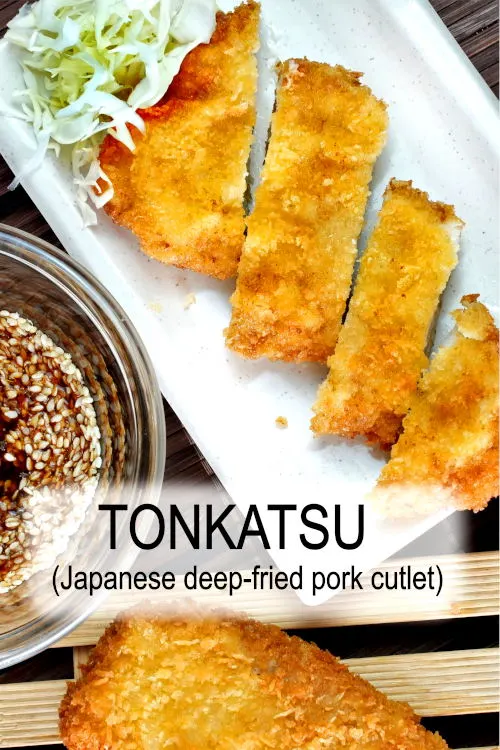
4. Deep-fry the pork
- Heat some vegetable oil in a large skillet, about 350°F/ 175°C.
- Make sure the pork loins are at room temperature. If you fry them cold, the breadcrumb might fall off.
- Place the pork loins into the hot oil gently to avoid spattering.
- Turn the meat once or twice to ensure even cooking.
- The duration of deep-frying depends on the thickness of the meat. Generally, it is about 6 minutes. The pork will cook at 66°C/ 150°F. The key to getting the tender tonkatsu is not overcooking it, as it will lose its moisture and dry above this temperature.
- You may want to skim the oil periodically with a fine wire mesh strainer to remove the bread crumbs floating on top. The excess bread crumbs will brown your oil.
- The endpoint is when it turns golden brown, and the pork starts to float to the surface.
- When it is ready, transfer the pork to a cooling rack and let it rest for a minute before cutting them into thick slices.
Note: You can use vegetable oil with high smoke points, such as cannula oil, palm oil, or corn oil, for deep-frying.
5. Make some cabbage salad
Usually, tonkatsu is served with cabbage salad. Cut the cabbage into thin strips either by hand or with a mandolin.
6. Grind some white sesame seeds
I like crushing some white sesame seeds to mix with the tonkatsu sauce to serve with the pork chops.
You can get a Suribachi bowl, Japanese mortar, and pestle with some grooves, which are made to crush the sesame seed easily. Otherwise, you can also do it with the standard mortar and pestle, which may take slightly longer.
7. To serve
Cut each piece of tonkatsu into 3/4 inch pieces to make it easy to eat.
Transfer to a serving plate and serve along with shredded cabbage. It is best to serve with miso soup, Japanese fried rice, or white rice.
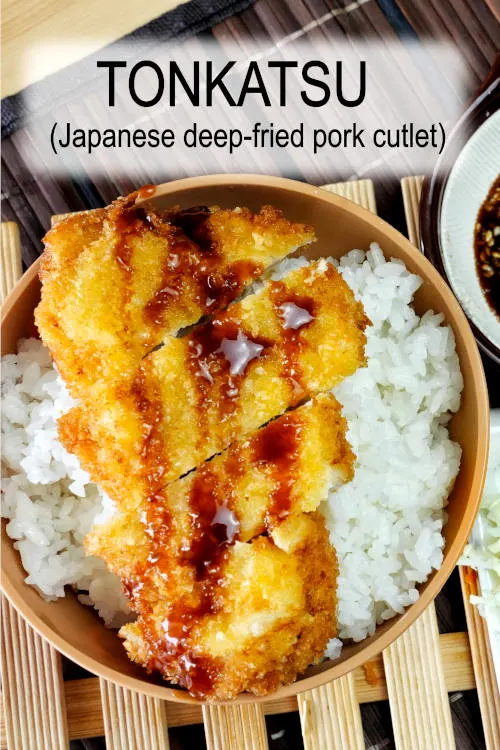
8. What is the difference between panko and regular bread crumbs?
Panko is made from crustless bread that is processed into flakes and then dried. The texture is drier and flakier than regular bread crumbs, and as a result, they absorb less oil.
How to make fresh panko breadcrumbs?
Panko bread Crumb is readily available in most supermarkets. However, if you want to make it yourself, Here are the steps.
- Buy a loaf of fresh bread, preferably on the sweeter side.
- Cut away the crust and then put it into the food processor.
- Use the pulse mode to process it to the size that you want.
9. Other Japanese foods for you if you like my tonkatsu recipe
I have some Japanese recipes on this blog for you if you like Japanese food. Here are my picks.
- Here is the chicken katsu recipe if you do not eat pork. The method of making it is the same as the pork katsu (tonkatsu).
- Here is the basic recipe for making miso soup. I strongly suggest you make this soup to serve along with tonkatsu.
Do you like Japanese dessert? This Japanese castella is best for you if you have a sweet tongue.
Tonkatsu (Japanese deep-fried pork cutlet)
What is Tonkatsu? It is pork chop coated with panko and deep fried. The Japanese deep-fried pork cutlets are among the most popular Western-style Japanese cuisine worldwide.
Ingredients
Brine
- 500g poor loins
- Sugar, salt, and warm water (see note)
Breading
- 100g panko
- 1 egg
- 1/2 cup all-purpose flour
Others
- Vegetable oil for frying
- 1 tbsp white sesame seeds
- 3 tbsp tonkatsu sauce
- Shredded cabbage to garnish
Instructions
Prepare the pork
- Stir to dissolve the salt and sugar in warm water and let it cools completely.
- Brine the pork loins for two to four hours.
- Remove the pork from the brine, place it on the rack, and allow it to dry.
- Place the pork loins on the cutting board.
- Use a meat mallet to pound the pork loins.
- Sprinkle some black pepper on both sides. (Not that you do not need salt if you brine the pork.)
Deep-fry the pork
- Put the pork chops into all-purpose flour in the first bowl.
- Next, dip it into beaten eggs in the second bowl.
- Lastly, cover with the panko bread crumbs in the third bowl. Press the pork loin lightly so that the bread crumbs here firmly on the surface.
- Heat some vegetable oil in a large skillet, about 350°F/ 175°C.
- Place the pork loins into the hot oil gently to avoid spattering.
- Turn the meat once or twice to ensure even cooking. Generally, it is about 6 minutes.
- The endpoint is when it turns golden brown, and the pork starts to float to the surface.
- When it is ready, transfer the pork to a cooling rack and let it rest for a minute before cutting them into thick slices.
To serve
- Cut each piece of tonkatsu into 3/4 inch pieces to make it easy to eat.
- Transfer to a serving plate and serve with shredded cabbage and tonkatsu sauce mixed with toasted white sesame seeds.
Notes
The brine consists of 2 tbsps sugar, 3 tbsps salt, and 1 liter warm water. Use 1.5 tbsp if you intend to brine the pork overnight.
Nnutritional value does not include oil as it is hard to know the amount of oil taken up by the pork
Recommended Products
As an Amazon Associate and member of other affiliate programs, I earn from qualifying purchases.
-
 Aliglow Meat Tenderizer, Dual-Sided, Meat Mallet, Meat Hammer
Aliglow Meat Tenderizer, Dual-Sided, Meat Mallet, Meat Hammer -
 Hamilton Beach 70725A 12-Cup Stack & Snap Food Processor and Vegetable Chopper Black
Hamilton Beach 70725A 12-Cup Stack & Snap Food Processor and Vegetable Chopper Black -
 Polly's Home Japanese Mortar and Pestle Set - Versatile Wooden Pestle and Mortar for Crushing Sesame Seeds, Garlic and Herbs - Ergonomic Japanese Suribachi Set - Ceramic Mortar Bowl Herb Grinder
Polly's Home Japanese Mortar and Pestle Set - Versatile Wooden Pestle and Mortar for Crushing Sesame Seeds, Garlic and Herbs - Ergonomic Japanese Suribachi Set - Ceramic Mortar Bowl Herb Grinder -
 Kikkoman Panko Japanese Style Bread Crumbs, 8 Oz
Kikkoman Panko Japanese Style Bread Crumbs, 8 Oz
Nutrition Information:
Yield: 6 Serving Size: 1Amount Per Serving: Calories: 178Total Fat: 6gSaturated Fat: 1gTrans Fat: 0gUnsaturated Fat: 4gCholesterol: 38mgSodium: 351mgCarbohydrates: 25gFiber: 2gSugar: 3gProtein: 6g
This data was provided and calculated by Nutritionix on 2/10/2022

KP Kwan
Tuesday 4th of October 2022
Hi, this is KP Kwan. I am happy to see you in this comment area, as you have read through my recipe. I am glad to reply to any questions and comments as soon as possible.